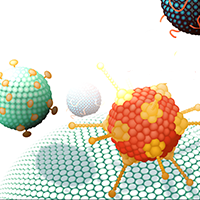Joined-up thinking: success criteria for tomorrow’s viral vector production platforms
Cell Gene Therapy Insights 2018; 4(10), 873-877.
10.18609/cgti.2018.101
Q How do you see the situation regarding the current shortfall in clinical and commercial vector manufacturing capacity evolving, and what are the key approaches to resolving this on-going issue?
PV: Well I think what we are experiencing here is that we are victims of our own success. Whilst we’re complaining about the challenges and shortage of vector production, it’s really reflective of the fact that these materials and products are having such strong clinical successes.
First and foremost let’s celebrate the fact that these materials are now in demand, and with that demand will come the need to industrialize and rethink how we transition from what has historically been carried out in translational clinical centres at smaller scale, using flasks and open systems, towards commercial production and methodologies.
There are a number of areas that will be consequential. First and foremost is the process itself. How can we improve efficiency in virus production? How can we change from planar surfaces, into 3D culture and suspension, just to get to those higher scales that the clinical trials as well as commercial products will require?
And finally, it’s like any other process. Looking across the workflow, looking at the process in its entirety, and trying to remove steps, remove complexity, remove labor, while improving the use of GMP materials such as chemically defined media, and ultimately coming up with cell lines that are highly efficient producers, but also have the regulatory provenance that is going to be needed.
Q In the rush to alleviate the capacity crunch, CMOs and other manufacturers are bringing much needed new facilities online. The current trend seems to be for large, empty rooms offering maximum flexibility in terms of tools and scale. What’s your opinion on this approach to resolve the supply and demand issue?
PV: I think it’s the only approach we can take at this point in time. We are an industry in transition, moving from translational centers, through clinical trials, where demand is increasing. And with the commercial successes we are now starting to see, as that scale continues we really have to bring an industrial mind-set into the production of these materials.
We’re in that transition now; therefore building facilities that are designed around today’s processes, may not translate as well into the technologies that are coming in the next 3-5 years. I think it’s essential that we keep flexible manufacturing, keeping open facilities with reconfigurable footprints and floor plans to accommodate new platforms that are coming, including new upstream technologies, whether bioreactors or other methodologies for scaling up, all the way through to downstream purification processes, all that’s going to change in the next 3–5 years.
Preserving that flexibility today for what will ultimately become a locked down, buttoned up process in 3–5 years, is probably the smartest approach.
Q The changeover from traditional adherent cell culture systems to efficient GMP suspension systems is a critical step for maturing viral vector driven cell and gene therapies. What are your views on both the technical and strategic obstacles to this transition?
PV: Whilst planar culture surfaces have demonstrated very high titers and efficiencies, one crucial problem is that they require quite a bit of labor owing to the need for manual intervention steps such as the feeding and passaging of cells, as well as the harvest of cells from those surfaces.As you look to scale up, these culture systems will also place increasing demands on your facility space – and quite simply, moving from flasks up to multi-layer flasks is not going to help us ultimately achieve the 1015-1016 viral particles that will be required for example in AAV manufacturing. Therefore there’s a need to move up to higher density culture system.
Harken back to what we have seen in the biologics industry, there was a move originally from some of these adherent cell types up into suspension CHO cell. That was the only way the industry could achieve the high concentration and productivity needed to support the product in the market, commercially.
The challenge we face as we’re exploring some of these suspension platforms is that even cell lines modified to grow in suspension, are still not achieving the productivity of those cells grown on planar surfaces. Whilst there is a recognised need to shift to suspension culture in larger bioreactors, whether they’re 100 litre, 1,000 litres or 10,000 litres or more, we haven’t solved the problem of efficiency of manufacturing. As we are pursuing these 3D culture systems, there’s also an ongoing need to resolve issues around the biology, the vectorology, and all of the process elements that will be influenced and necessarily changed to accommodate that scale up.
Q Have you had much engagement with global regulatory agencies to get a sense that they are proactively involved in wanting to work with the sector around this issue?
PV: From my experience, the regulatory agencies are very much engaged and involved. There’s an understanding that as the demands for these materials increases dramatically, that there has to be an accommodation for shifting manufacturing methodologies just to accommodate the promise of these therapies.
That said I think there’s two things we [as an industry] have to give some thought to. The first and foremost is that as you change and introduce new manufacturing processes, whether it’s vector, or even a biologic or cell therapy, we have to have good analytical tools to make sure whatever we’re producing in the platform, in the technology we’re employing, that there is comparability. That we can demonstrate that the materials biochemically and physiology are as close to or identical to the materials made and used in the earlier clinical trials.
The second thing is there’s really no shortcut. As we [as an industry] develop these materials, we will have to put them through clinical trials. We’ll have to look for safety. We’ll have to evaluate the newly manufactured materials for the ability to carry out the therapeutic effect we’re looking for.
In the world of biological medicine there really are no shortcuts. We have to try the brute force approach: after we demonstrate safety and comparability, just put them into trials and see how they perform.
Q What impact will the technical evolution of upstream processes have on the downstream bioprocessing and are assays the key to being able to efficiently address these knock-on effects?
PV: It’s part of the answer but there are so many moving parts. As you’re thinking about manufacturing and production, you have to look at it as a continuum, an entire process. Looking at individual steps or unit operations of the procedure, all of these have derivative or ripple effects through the process. And it really starts upstream with the vectorology, the design of the producer construct you’re going to be using, whether it’s the gene of interest or the other packaging and helper lines. All of these components have implications on the overall efficiency of your manufacturing processes.
It’s therefore important that we approach our manufacturing strategy with that in mind: that every time we change or shift one part it influences the next step in the process. For example if we move from planar surfaces into suspension culture, or we go from a batch process to a continuous manufacturing process, each of those has consequences in terms of the volume of culture that we require, the scale, and the facility that culture is carried out in. It influences how we think about initially lysing cells, clarifying the raw material, putting it through the series of chromatography steps to clean up and purify the viral particles so they can be qualified and used downstream, all the way through to the final fill-finish packaging. Everything that we do has an impact. And some of these technologies, as we move to chemically defined cGMP, changes in culture conditions, larger bioreactors, or processing platforms downstream, each of those brings with it some benefit, but potentially some consequences in terms of the quality of material, efficiency of each of the individual steps, upstream and downstream, and then ultimately those have to be validated.
Therefore, whilst I believe analytical tools will absolutely be critical for assessing any change we make in the process, at the end of the day it’s really going to come down to better vectorology, or better ability to design and control the production of vectors. Then marrying those up into connected processes, such that every step is optimised, whilst constantly thinking about the entirety of the procedure, such that we can achieve our goal of high quality, contaminant-free products and with a full and GMP compliance as well as regulatory track record.
Q Is there value in creating a vector manufacturing platform similar to what we’ve seen in protein bioprocessing?
PV: I think this is a theme worth exploring a little bit. We talk amongst ourselves in the industry of the requirement for standards and the requirement for better control of raw materials and processes all the way through manufacturing. Therefore, certainly there would be value to a standardised or platform approach to these such that they could be shared and disseminated.
What we’re looking for however is more of what does ‘good’ look like in manufacturing? What is a quality vector? Remember we have lots of different viruses being manufactured, in cell and gene therapy it’s principally AAV and lentivirus. But everything that is designed into a virus to carry out the therapeutic effect, whether it’s a gene of interest that is going to have a modification effect in vivo, or whether it’s a CART antigen presented in a cell. Each of those may influence the ability to subscribe to a single standard approach or method.
So arguably yes, I think there would be an interest in increasing and providing a standard methodology or platform. However the challenge will be variability and differences in the vectorology that will have a knock on effect and consequence of making that happen or not.
Q How are biomanufacturers solving the need to develop efficient processes quickly while having limited feed stream material to work with?
PV: This is a great question and is something we hear very often. Process development is a very expensive endeavour, especially when trying to push it to these larger scales. A 200 litre AAV production run can be quite costly, so trying to optimise and manage the changes in process, whether moving from planar surfaces to suspension culture, optimising the conditions for transfection if you’re in a transient platform, or optimising the approach of building packaging cell lines or establishing stable producer cell line, all of those will require what I would call high dynamic range systems.
A platform where you carry out all your process development and evaluation at small scale will be necessary to enable you to scale to larger bioreactors with confidence, as well as all the downstream chromatography and filtration applications that will need to scale predictably across the scales that you’re working.
That’s going to be the key trick I think to these, having technologies that scale very robustly, reliably, and most importantly predictably.
Q There are many moving parts in vector production using current systems. What do you think we should be locking down first? And what strategic framework do you suggest biomanufacturers consider?
PV: That’s a really difficult question as I don’t think there’s a shortcut to addressing all the pain points in the process. Certainly we hear quite a bit on the downstream side of manufacturing for example the low yields from final filtration. If you consider the current manufacture of lentivirus, we hear that yields in the 40% range are considered ‘good’. If I had a biologic and had only a 40% efficiency of recovery at the end of the process I would not consider myself very successful, but that’s where we are in the industry today.
We need to prioritise addressing the steps in the process that have the highest cost drivers (often the highest labor intensity), and then the ones that have the lowest recovery or efficiency in yields.
At the same time we need to start thinking about suspension-enabled cells, just to get to the higher culture density we need so we can simply produce more viral particles in a particular batch. That’s going to be a critical element.
Other areas for improvement include downstream steps and products including affinity resins for certain AAV molecules, ion exchange and notably filtration steps. Each one will be slightly different and require the ability to look at the manufacturing process in its entirety.
In addition, if there was a capability or technology that could help stabilise the labile viral particles during the production process, without influencing the viability or infectivity of those viral particles downstream, that would be quite helpful as well.
So there’s a number of individual steps. From a process perspective the rule of thumb is go after what’s driving costs, what’s driving efficiency losses, and what’s contributing to high labor and touch points in the process. Those would be the areas I would encourage people to think long and hard on.
Q As the industry grows, the need for experienced professionals is ramping up as well. How are industry players addressing the growing talent gap?
PV: It’s prevalent all the way through cell and gene therapy. There’s not enough people today that are very experienced in this sector and there’s an element of us all learning as we go. And that’s ok.
In the viral and vector side of the world, there is a lot of conservation of experience from the bioprocess industry. Viral manufacturing, for the most part, looks and feels a lot like the biologics manufacturing process. So there is a skillset being pulled over from that part of the world, and they’re having quite a bit of success. The big challenge we face, as I mentioned earlier, is that a lot of the processes being used today for manufacturing are coming from the translational centers. They had an acute need and they built their own vector cores in which they are manufacturing relatively small batches – these processes will not necessarily translate readily into industrialisation or commercial-scale manufacturing.
To try to address these challenges, we’re going to need to bring more bioprocess individuals into the viral space and now that there is a huge demand for these materials I think that will happen.
The other focus needs to be on open communication and partnerships with the clinical and academic centers to support training initiatives. To have centres of excellence established where we can actually try technologies in the real world, but also at the same time bring people in to train and learn from others is the ultimate goal. It’s also building a network of key opinion leaders who have done this, done it at scale, to make sure there’s a community of likeminded individuals trying to solve this big problem.
Scalability, the science, the biology, the manufacturing, the quality – all of those things have been done in other industries. So we just have to borrow heavily from what we’ve already learned, and be willing to admit we don’t know everything at this point in time.
Affiliation
Affiliation
Philip G Vanek
GM Cell and Gene Therapy Strategy,
GE Healthcare
This work is licensed under a Creative Commons Attribution- NonCommercial – NoDerivatives 4.0 International License.




